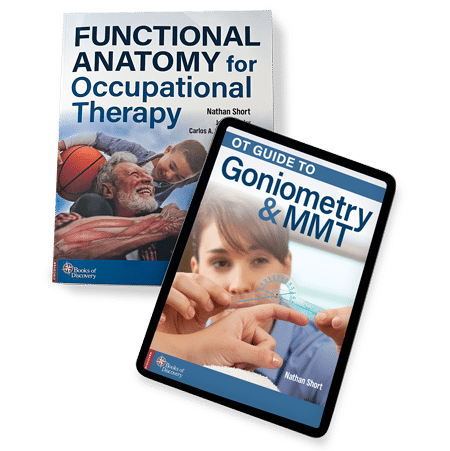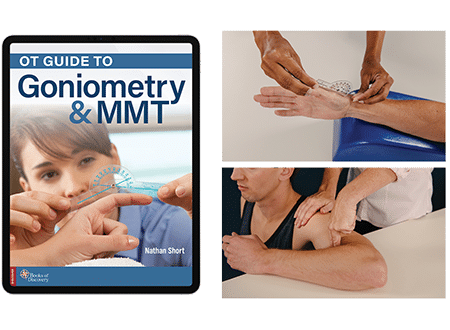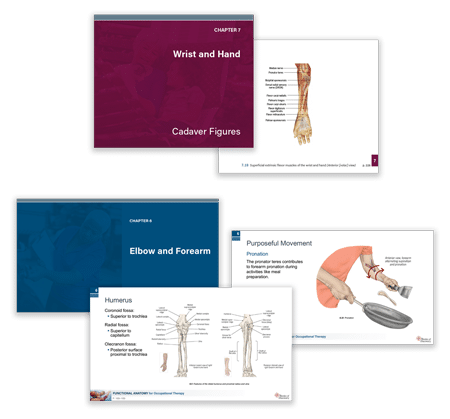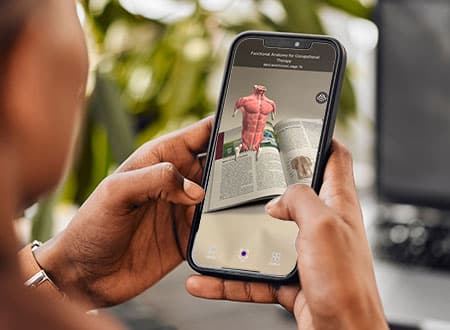Functional Anatomy for Occupational Therapy is the “just right challenge” to optimize learning for occupational therapy students. It includes the correct amount of depth with adequate detail, yet it does not oversimplify things. It is written specifically for occupational therapy students and puts occupation in the forefront. As always with Books of Discovery textbooks, the exceptional images add to the clarity of the concepts. I think occupational therapy students will engage with this text and enjoy learning the important foundational content.”
Finally… an OT approach to functional anatomy.
Gives entry-level OT/OTA students a sound understanding of occupation and function.
Written by a practicing OT, Functional Anatomy for Occupational Therapy is an occupation-centered textbook geared specifically towards students beginning their journey as an occupational therapist (OT) or occupational therapy assistant (OTA). Perhaps some of your students want to work with children, using play-based interventions to help them reach developmental milestones. Or, they wish to work in a rehabilitation setting, helping people with their activities of daily living (ADLs) and instrumental activities of daily living (IADLs). Regardless of the setting or population, this textbook provides students with a sound understanding of functional anatomy.

Takes the mystery out of functional anatomy with eye-catching muscle overlays and cadaver images.
With more than 1,000 images, including 200 muscle overlays of functional movement, and 51 detailed cadaver images, the textbook is one of the best occupational therapy textbooks serving as an excellent visual resource for entry-level OT students.
Uses a conversational writing style that connects with students.
Providing students the “just right challenge,” this textbook conveys complex material clearly, in a context that gives it meaning. Functional Anatomy for Occupational Therapy uses a patient-centered approach, grounding the functional anatomy content in patients’ daily occupations. See sample pages.

Lays the foundation for students to practice in various clinical settings with patients across the lifespan.
Functional Anatomy for Occupational Therapy covers a multitude of topics that prepare OT or OTA students as future practitioners. Topics include therapy for upper and lower extremities, functional mobility, orthopedics, pediatrics, neurological disorders, pelvic floor issues, and patient transfers. See product details.
Offers clinically relevant learning experiences.
Occupational Profiles woven throughout the textbook provide a personalized path for understanding and applying the principles of functional anatomy. Students will see the clinical relevance of the content and make real-life connections to their future careers. See sample pages.
Becomes a resource for future coursework and life-long clinical reference
This textbook prepares your students to excel in your course, as well as in future classes throughout the program. Whether working in a clinic or hospital setting, this textbook become a trusted, practical reference for their professional careers. See sample pages.

Comes with a FREE companion eTextbook: OT Guide to Goniometry & MMT
Together, they cover functional anatomy, goniometry, and MMT—all in a single resource!
Measuring purposeful movement and strength during clinical assessments supplies key information for evaluating occupational performance and tracking progress in many practice settings. The OT Guide to Goniometry & MMT puts this core knowledge at your students’ fingertips, as near as a tablet or computer.
Together, Functional Anatomy for Occupational Therapy and OT Guide to Goniometry & MMT provide everything instructors need to teach functional anatomy, goniometry, and MMT content. Now wrapped into one resource, multiple textbooks are no longer required. Your students will see a significant cost savings by purchasing this one comprehensive title. See eTextbook details.

Meets the latest accreditation standards.
Functional Anatomy for Occupational Therapy and OT Guide to Goniometry & MMT meet ACOTE standard B.1.1 for OTA/OT programs and standardized assessments related to standard B.4.5 for OTs.
Comes with resources for quickly creating dynamic lessons.
As a Functional Anatomy for Occupational Therapy instructor, you’ll gain easy access to a full suite of resources that help you create dynamic, multi-faceted lessons with ease. From PowerPoint presentations and a vast image library to unique classroom activities, these resources save you time and capture your students’ attention.

And a FREE app— Ludenso Explore takes students on an immersive learning journey.

